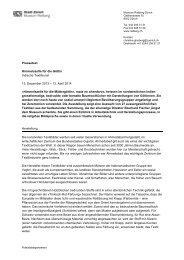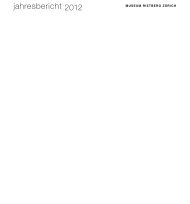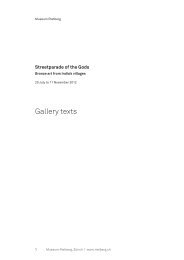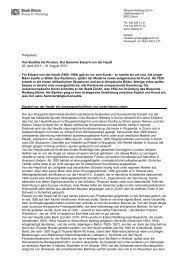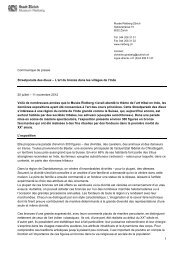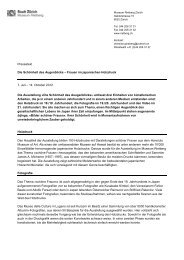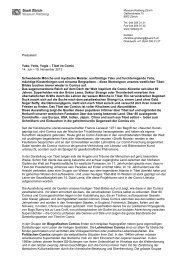1.1 eduard von der heydt - Museum Rietberg
1.1 eduard von der heydt - Museum Rietberg
1.1 eduard von der heydt - Museum Rietberg
Create successful ePaper yourself
Turn your PDF publications into a flip-book with our unique Google optimized e-Paper software.
4.1<br />
die «mo<strong>der</strong>ne»<br />
im leben<br />
<strong>von</strong> <strong>der</strong> <strong>heydt</strong>s<br />
Berlin war gegen Ende <strong>der</strong> 1920er- und zu Beginn<br />
<strong>der</strong> 1930er-Jahre neben Zandvoort und Ascona <strong>von</strong><br />
<strong>der</strong> Heydts zentraler Wirkungsort. Mittlerweile geschieden,<br />
führte er hier ein dynamisches Junggesellenleben, nahm Teil<br />
an gesellschaftlichen Anlässen und war ein gern gesehener<br />
Gast in Künstler-, Schriftsteller-, Diplomaten- und Industriellenkreisen.<br />
Der Kunstmarkt boomte, und <strong>von</strong> <strong>der</strong> Heydt<br />
tätigte zahlreiche Erwerbungen – <strong>von</strong> denen er viele an die<br />
Nationalgalerie auslieh, insbeson<strong>der</strong>e für die «Galerie <strong>der</strong><br />
Lebenden», eine zur damaligen Zeit sehr fortschrittliche Abteilung<br />
für zeitgenössische Kunst.<br />
In Berlin hatte Eduard <strong>von</strong> <strong>der</strong> Heydt verschiedene<br />
Wohnsitze, darunter ein Weekend-Häuschen am Golfplatz<br />
beim Wannsee. Dieses 1927 vom Architekten Karl Hoffmann<br />
errichtete Gebäude liess er 1929 <strong>von</strong> Marcel Breuer im<br />
Bauhaus-Stil erweitern und einrichten. Stühle und Tische<br />
sowie massgefertigte Schränke <strong>von</strong> Breuer waren en vogue.<br />
Nur wenige Kunstwerke wurden aufgestellt – dafür sehr<br />
effektvoll. Hier zeigte sich <strong>der</strong> national-konservativ eingestellte<br />
Freiherr und Bankier als ein puristischer Gefolgsmann<br />
<strong>der</strong> Mo<strong>der</strong>ne.<br />
4.1<br />
the role of<br />
“mo<strong>der</strong>nism” in<br />
the life of<br />
<strong>von</strong> <strong>der</strong> <strong>heydt</strong><br />
At the end of the 1920s and at the beginning<br />
of the 1930s, along with Zandvoort and Ascona, Berlin was<br />
<strong>von</strong> <strong>der</strong> Heydt’s centre of activity. By now divorced, he led a<br />
busy bachelor life, took part in society gatherings, and was<br />
a welcome guest in artistic, literary, diplomatic and business<br />
circles. The art market boomed and <strong>von</strong> <strong>der</strong> Heydt made<br />
numerous acquisitions of which he loaned many to the<br />
Nationalgalerie in Berlin, especially for the “Gallery of the<br />
Living”, a department for contemporary art that was very<br />
progressive for its time.<br />
Eduard <strong>von</strong> <strong>der</strong> Heydt had several homes, including<br />
a weekend house next to the waterside golf course<br />
at the Wannsee. Built in 1927 by the architect Karl Hoffmann,<br />
the house was enlarged and furnished in Bauhaus style by<br />
Marcel Beuer in 1929. Chairs and tables as well as made-tomeasure<br />
cupboards by Breuer were in vogue at the time. Few<br />
artworks were displayed in the house – and these were all<br />
the more effective for this reason. This was the place where<br />
the national-conservative baron and banker showed himself<br />
to also be a purist follower of mo<strong>der</strong>nism.<br />
4.1<br />
Le «mo<strong>der</strong>nisme»<br />
dans la<br />
vie d’<strong>eduard</strong> <strong>von</strong><br />
<strong>der</strong> <strong>heydt</strong><br />
De la fin des années 1920 au début des années<br />
1930, Berlin sera, en dehors de Zandvoort et d’Ascona, le principal<br />
lieu de résidence du baron <strong>von</strong> <strong>der</strong> Heydt. Entretemps<br />
divorcé, il y menait une vie de célibataire dynamique, participait<br />
activement à la vie mondaine et était le bienvenu dans les<br />
cercles d’artistes, d’écrivains, de diplomates et d’industriels.<br />
Le marché de l’art connaissait alors un véritable essor et <strong>von</strong><br />
<strong>der</strong> Heydt fit de nombreuses acquisitions. Bon nombre de ces<br />
œuvres furent prêtées à la Nationalgalerie, notamment pour<br />
la «Galerie des vivants», un département d’art contemporain<br />
très progressiste pour l’époque.<br />
A Berlin, Eduard <strong>von</strong> <strong>der</strong> Heydt avait différents<br />
domiciles, parmi lesquels une petite maison de week-end<br />
sur le terrain de golf du Wannsee. En 1929, il chargea Marcel<br />
Breuer d’agrandir ce bâtiment qui avait été érigé par l’architecte<br />
Karl Hoffmann en 1927 et de l’aménager dans le style<br />
Bauhaus – les chaises et les tables de Breuer ainsi que ses<br />
placards fabriqués sur mesure étaient alors à la mode. Seules<br />
quelques œuvres d’art y étaient exposées – mais de manière<br />
tout à fait spectaculaire. Le baron <strong>von</strong> <strong>der</strong> Heydt, plutôt<br />
nationaliste et conservateur, s’avérait être ici un fervent<br />
adepte du purisme mo<strong>der</strong>niste.<br />
Golfhaus (golf house / maison de golf), Wannsee, Berlin, 1930<br />
(Marta Huth, Berlin)






